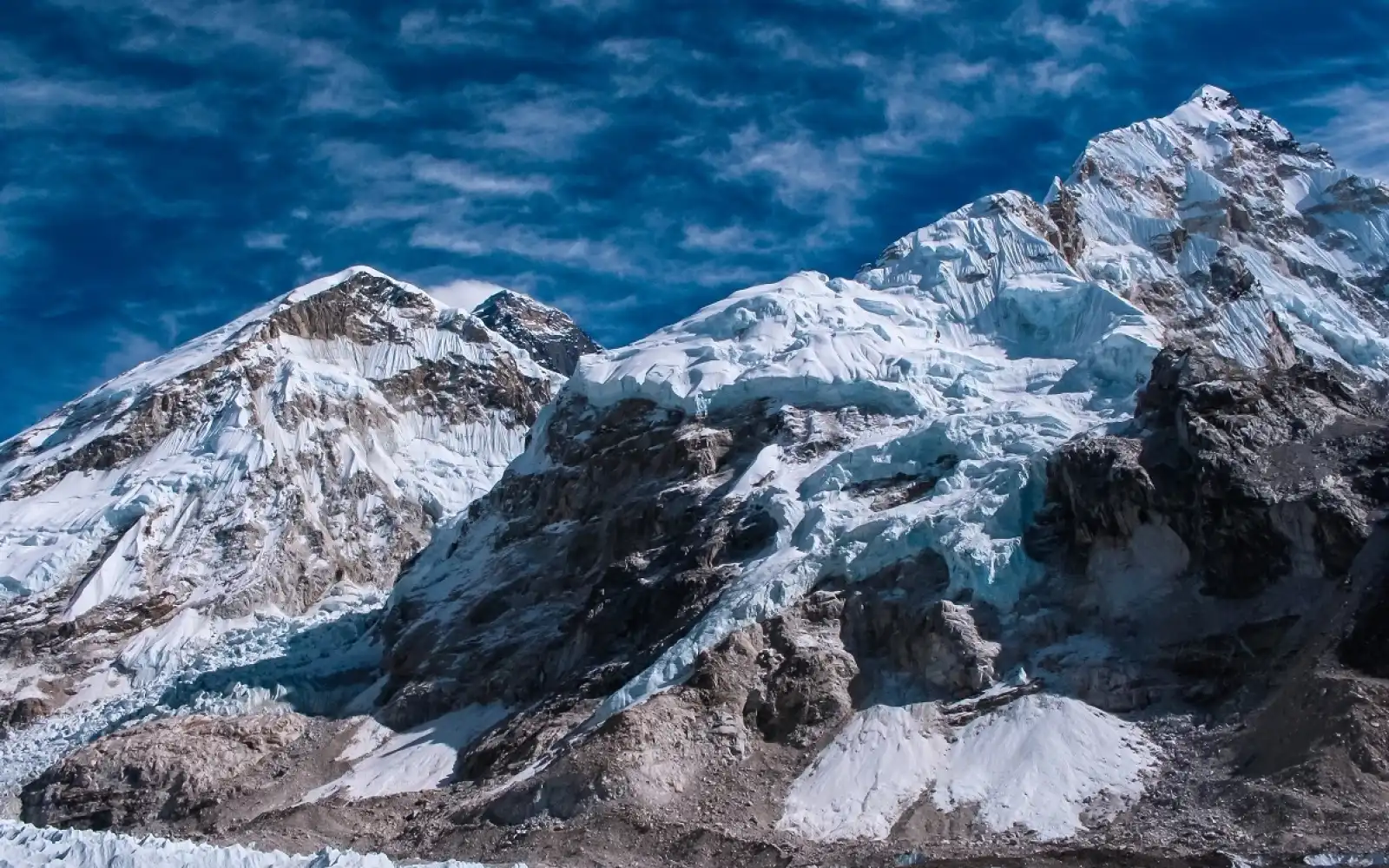


Aside from this, the trek also sees quaint villages, pine forest, ridges at height, and white-flanked paths. Trekkers trek through places like Namche Bazaar (3,440 meters) and Tengboche Monastery (3,860 meters). The trek develops gradually, which is for acclimatization and safety. Similarly, you get to see majestic mountains like Lhotse (8,516 meters), Nuptse (7,861 meters), and Ama Dablam (6,812 meters). So, the scenery is majestic and vibrant.
Likewise, Everest Base Camp is steeped in history and significance. It is the starting point of the mountaineers ascending to the summit of Everest. During the expedition season, multicolored tents blanket the rocky camp ground. Prayer flags fluttering in the biting cold wind imbue the air with a spiritual atmosphere. Because of the atmosphere, the trekkers get excited and humble.
Besides, reaching the base camp is a feat in itself for the majority of the trekkers. Even though non-technical, high altitude puts the body and mind to test. Trekkers feel proud and emotional upon reaching. The majority loiter around clicking photographs and soaking in sights of the glacier. Therefore, the experience is memorable forever.
Last but not least, Everest Base Camp is not merely a destination. It is the synthesis of natural scenery, cultural richness, and personal test. From challenging paths to religious places, every moment of the journey is distinctive. Because of all these reasons, Everest Base Camp remains Nepal's most legendary and unforgettable trek.
In addition, the region around is endowed with tall peaks and glacial landscape. Mountains like Lhotse (8,516 m), Nuptse (7,861 m), and Pumori (7,161 m) loom on the horizon. The base camp is on the fringes of the Khumbu Glacier. Likewise, trekkers walk over moraines, glacial rivers, and rising ridges. Thus, the surroundings are raw, brutal, and extremely beautiful.
Besides, the trek to Everest base camp begins at Lukla (2,860 meters). The path then follows through villages of Phakding (2,610 meters), Namche Bazaar (3,440 meters), and Tengboche (3,860 meters). Then ascends to Dingboche (4,410 meters) and Lobuche (4,910 meters). Finally, moves on to Gorakshep (5,164 meters), the penultimate destination to Everest Base Camp. Hence, the path gradually increases in altitude and difficulty of terrain.
Likewise, the terrain also changes. Pine forests and fields occur at the lower terrain. Rhododendron trees and alpine shrubs occur at mid-altitude. Above 4,000 meters, the terrain is dry, rocky, and windy. Snow and ice protect upper terrain. Because of the high altitude, the weather changes quickly and extensively. Therefore, the trekker must be most equipped.
Moreover, the area is part of a UNESCO World Heritage Site. It has a distinctive geological, environmental, and cultural value. Snowy cliffs, hanging glaciers, and gorges define the area. Snow cocks and Himalayan tahrs are among the wildlife found in the region. The base camp is, therefore, in a fragile but alluring ecosystem.
In short, Everest Base Camp is located in one of the world's most gorgeous environments. It offers towering peaks, icy trails, and wonderful mountain valleys. Because of its altitude and rugged terrain, it enthralls every single visitor. Thus, its location and geography make it an absolutely unforgettable spot.
But it depends upon weather conditions for flights to Lukla. Delays are common because of clouds or wind. In the same manner, flights operate from Manthali Airport in peak seasons. Manthali is located at approximately 4–5 hours' road distance from Kathmandu. Thus, travel arrangements have to be flexible.
Apart from that, the walk from Lukla to Everest Base Camp also takes 8 to 12 days. The route passes through significant villages like Phakding (2,610 meters) and Namche Bazaar (3,440 meters). It then ascends further through Tengboche (3,860 meters), Dingboche (4,410 meters), and Lobuche (4,910 meters). The trekkers finally ascend to Gorakshep (5,164 meters), and then to Everest Base Camp (5,364 meters). So, the route ascends gradually but steadily.
Similarly, the hiking trail also has suspension bridges, rocky steps, and steep climbs. Most of the trail has well-defined and well-manicured trails. Porters and yaks carry goods on the trail. So, tourists easily walk without carrying heavy bags.
Additionally, a different access route is also possible for flight avoiders. It is possible to trek to Everest Base Camp from Jiri or Salleri by road. These treks take a few extra days to reach Lukla. But, they have fewer human beings and gentle altitude acclimatization. Compared to the flight trail, road treks have better acclimatization. Thus, they suit those with extra time.
Also, helicopters offer quick transport to and from Everest Base Camp. They are expensive but time-efficient. A few trekkers fly back after reaching the base camp. Others use helicopters in case of an emergency. So, they're both a luxury and an insurance.
Overall, Everest Base Camp is within reach for most physically capable hikers. You can fly to Lukla or trek in from Jiri or Salleri. Though remote, the path is well-beaten and supported. So, Everest Base Camp remains one of Nepal's most accessible high-altitude points.
Actually, most of the people begin their EBC Trek from lower altitude points like Lukla or Phakding. These are relatively lower in elevation. When they go up, their body has time to acclimatize. Compared to normal traveling, traveling fast here is dangerous. Thus, spending extra nights at crucial points like Namche and Dingboche gives the body time to acclimatize.
Similarly, rest days are not merely passed sleeping. Visitors or mountaineers usually engage in brief climbs to a higher level. They return to sleep at lower levels thereafter. This "climb high, sleep low" tactic enables the body to acclimatize naturally. Similarly, drinking a lot of water is also extremely important.
In addition, alcohol and tobacco abstinence is highly recommended. Both prolong the acclimatization period. Hot and nutritious food intake also keeps energy levels unchanged. Therefore, little things do matter at high altitudes.
If a person is not feeling well, symptoms can be headaches, nausea, and exhaustion. These are not something to be taken lightly. Unlike normal sickness, altitude sickness has the potential to become severe very rapidly. If the symptoms become worse, descending to a lower altitude is the ideal remedy. Drugs such as Diamox can assist, but they will not totally cure it.
Moreover, Everest Base Camp is windy and cold. Weather changes at that elevation quickly. It snows frequently and there are high winds. For this reason, people must be warm, dry, and alert.
Finally, Everest Base Camp demands respect for altitude. Walking slowly, taking good care, and being vigilant, reaching it is safe and rewarding. Altitude is not a barrier—it is part of the journey.
In addition, Everest Base Camp consists of temporary tents and essential items. Most of the tents are set up by expedition teams. A tent can include beds, sleeping bags, and ground mats. Similarly, independent tents are used for dining, kitchen, and storage. All have to be carried from lower areas such as Gorakshep and Lobuche.
Actually, satellite phones are accessible in communication terms. Solar panels or generators provide limited power. These are employed to charge small appliances, radios, and lights. Normal mobile or internet networks aren't available under normal circumstances. People hence depend on radio or satellite networks to access the outside world.
Moreover, water sources in EBC are few and mainly obtained from the melting of snow or glacial ice. Boiled or filtered water is used. Apart from this, gas cylinder or kerosene is also used for cooking. Firewood is not used here, as in the lower regions. Thus, fuel is carefully maintained and used efficiently.
Meanwhile, food in Everest Base Camp is dull but inciting. Rice, pasta, soup, and vegetables constitute the food. High-protein and high-carbohydrate diet is the preference. Similarly, hot drinks like tea, hot lemon, or soup are also taken in large numbers. Appetite might be reduced because of altitude, but food taking becomes unavoidable.
Furthermore, toilets in Everest Base Camp are typically pit-type or barrel toilets. Sanitation is simple but kept in order. Teams attempt to reduce waste to preserve the delicate ecosystem. Waste and trash are taken down whenever it is feasible. In recent years, there has been more emphasis on sustainability. Thus, hygiene is getting better with each passing season.
In addition to, medical care at EBC is limited. A few expeditions have doctors. Others employ satellite phones for consultancy. Thus, all climbers are required to carry basic first aid kits and altitude medicines.
In short, Everest Base Camp has limited but necessary facilities. All these here increase safety, survival, and summit attempts. Although primitive, these facilities are enough comfort in such extreme altitude.
Moreover, visitors often walk to the nearby Kala Patthar, which is 5,545 meters high. From there, people get the most impressive panoramic view of Everest and surrounding peaks. The sunrise or sunset over Kala Patthar is simply breathtaking. Intimate contact with the peaceful Himalayas is provided through this activity. For this reason, several find it a trip highlight.
Additionally, tourists get to view climbers' expedition preparation set-ups typically at base camp. Tourists watch set-ups of teams pitching camps, organizing equipment, and preparing supplies. This glimpse behind the scenes portrays the workhorse effort that goes into high altitude mountaineering. Similarly, tourists assess Sherpa culture and how they play a crucial role in expeditions. Buddhist chortens and prayer flags envelop tourists with spiritual ambiance. Therefore, appreciation for culture provides meaning to the visit.
Also, socializing with fellow visitors and climbers is a popular hobby. Swapping stories, experiences, and advice brings people together in this remote location. The camp is a community of adventurers and trekkers. Likewise, a rest and acclimatization at Gorakshep (5,164 meters) before or after the visit to the base camp is common. This proximity location provides basic facilities and a chance to acclimatize to higher altitudes.
Lastly, Everest Base Camp is not merely about getting to the destination. With activities ranging from glacier and viewpoint hikes to culture and human interaction, one stays engaged. Because of these various activities, the base camp is a happening and memorable place for all.
In short, Everest Base Camp is coveted for so many reasons. That it is situated beneath Mount Everest makes it legendary. Natural scenery and colorful culture enrich the experience. Moreover, ease of access makes it accessible to many so they can see its magic. Thus, it is Nepal's most featured high-altitude destination.
Expedition teams set up base camp tents during climbing seasons. Climbers utilize these tents as living space, kitchen, and dining area. The tents are fortified to withstand strong winds and freezing temperatures. Tents also provide some warmth via sleeping bags and insulation mattresses. There is minimal comfort because of the altitude and cold temperatures.
There are no permanent restaurants or shops at Everest Base Camp. Food is carried up along with everything from lower villages. Cooking gas cylinders are supplied by the expedition teams. Water is mainly melted snow or glacial ice and is boiled for safety purposes. Hygiene facilities are extremely basic, and largely portable toilets.
Power is scarce in the base camp. Portable solar panels or a generator supply lighting and communication gear. Satellite phones are required for emergencies. Mobile phone reception is typically not optimal at this altitude. Wi-Fi is hardly existent.
The majority of travelers spend mere hours at Everest Base Camp. They return to the neighboring Gorakshep, which is at 5,164 meters, for overnight accommodation. Gorakshep boasts the nearest tea houses that have rooms at a basic level, eatables, and hot shower facility at a price. Therefore, Gorakshep serves as the main lodging hub near Everest Base Camp.
In total, Everest Base Camp accommodation is temporary and rudimentary. The camp is mostly utilized as a staging ground by climbers. It lacks adequate facilities but provides the mere shelter and support within an extreme condition. Guests must plan ahead.

